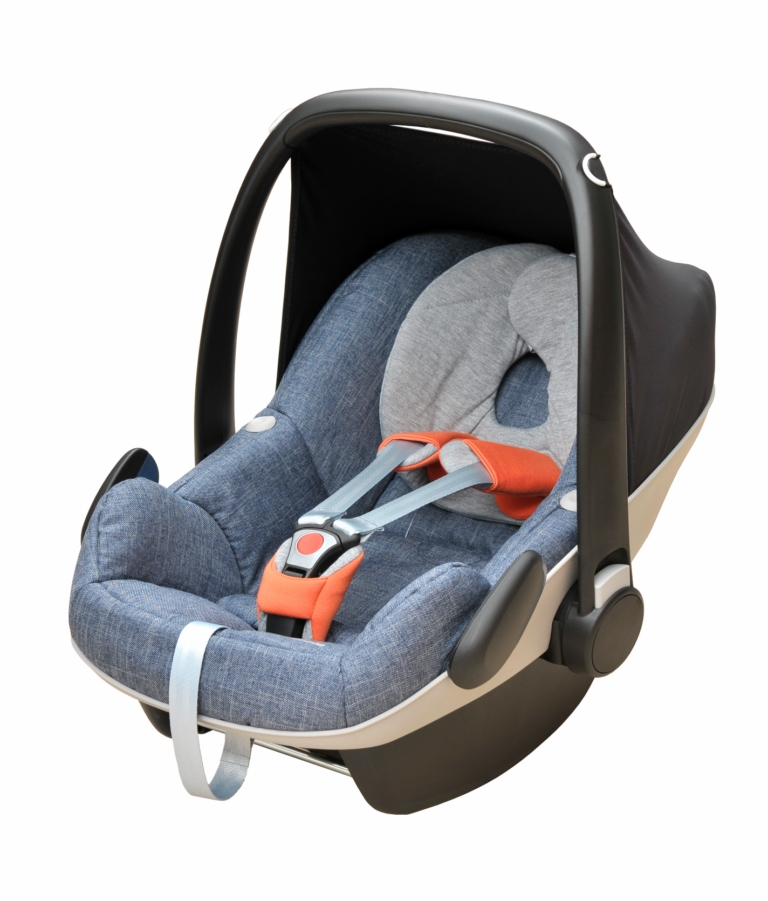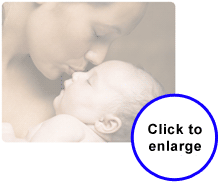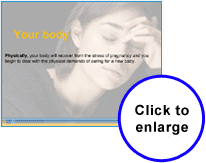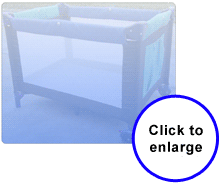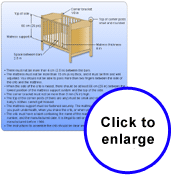MODULE 8
Healthy Family
c. Starting Your Period again
After childbirth, you will continue to have vaginal discharge for several weeks. This is called lochia
If you breastfeed, you may not have a regular period for months or until you stop breastfeeding. If you are formula feeding, your period will probably return between 4 and 9 weeks after you have your baby. Your first period after delivery may be heavier and last longer than your period normally does.

Once your period returns, it may be irregular for a while. This is normal. You should know that you can get pregnant before your period returns. If you do not want to get pregnant, you should use some type of birth control.
b. Your Body after Pregnancy
During the first six weeks following your baby's birth, your body goes through many changes. Here are a few.
Remember that you were pregnant for nine months. It takes a while for your body to recover and feel "normal" again.
Most women have a postpartum checkup about six weeks after giving birth. This checkup gives you a chance to talk to your health care provider about your questions and your concerns. This is a good time to talk about birth control.
a. Adjusting to Motherhood
By taking care of yourself, it will be easier to take care of your baby.
Childbirth has an impact on all the aspects of your life. Here are some examples.
These changes seem to happen all at once and are all mixed up. You may not know why you feel so overwhelmed. You just know that you feel that way. You may even be surprised to feel this way.
All these conflicting feelings come at a time when you are extremely tired. Everything seems more difficult when you are tired.
Sharing your feelings with your partner is especially important now. If you feel tired, or lonely, or resentful, say so. You may find that your partner feels the same way.
Talking with other new mothers can also help to reassure you. When they share how they feel, you will see that you are NOT alone.
D. HEALTHY MOTHER
The first weeks after childbirth are a time of change and adjustment. You must adapt to several new things.
These are the best things you can do for yourself.
- Rest as much as you can.
- Eat healthy.
- Accept help from others.
- Share your feelings with your partner and others you care about.
2. Playpens
1. Cribs
Cribs manufactured before September 1986 do not meet today's safety standards. It is illegal to sell cribs manufactured before September 1986. These cribs are not safe for the baby and could result in serious injuries and even death.
If you buy a new crib, you can be sure it conforms to the rules. The manufactured date should be visible on the crib.
If you buy a used crib, check it carefully. Used items do not always meet the Canadian Standardization Association (CSA) Standards.
This exercise will help you check if the crib is safe.
 |
Because of the risk of SIDS (Sudden Infant Death Syndrome), soft mattresse, pillows, comforters, stuffed toys, blankets and bumpter pads should not be used in cribs. |
2. Securing a Car Seat
To be safe, car seats must be installed and used in accordance with the manufacturer. Read the instructions carefully before using the car seat.
Before buying a new or used car seat, try it in your car. Be sure that you can install the car seat safely and that you can adjust the seat belt. Check to see if it is easy to use. Read the instructions and practice using the car seat.
Never use a car seat that is past the expiry date because materials deteriorate with time. Never buy or use a car seat that was involved in a collision.
Using a rear-facing car seat (for infants under 10 kg or 22lbs)
- Always follow the car seat manufacturer’s instructions.
- Rear facing car seats should face the back of the vehicle and rest on a 45-degree angle and move no more than 2.5cm (1in.) from side-to side.
- The shoulder harness straps must be threaded through the seat back at, or slightly below, the child’s shoulders.
- You should not be able to fit more than one finger underneath the harness straps at the child’s collarbone.
- The chest clip should be flat against the chest at armpit level.
- Keep your child in a rear facing car seat until he/she outgrows the maximum height or weight of his/her infant seat and then use an infant/child seat rear facing until he/she is at least 10kg (22lbs) and is able to walk.
For more information about car seats visit:
- http://www2.gnb.ca/content/gnb/fr/ministeres/securite_publique/conducteu... 1-506-453-2410
- Transport Canada: www.tc.gc.ca
 |
Never install a baby car seat equipped with an air bag. |
c. Furniture
In the beginning, you will need a little furniture. Your baby will need an approved cradle, crib or bassinette to sleep in. You will need an area for the baby's clothes such as a bureau or even a box. Rocking chairs are not necessary, but many parents and babies enjoy them.
Each piece of furniture you purchase for your baby must be clean, safe, and well made. Old furniture is not always safe.
1. A Safe Car Seat
Babies must travel in a baby car seat until they weigh 9 or 10 kg (20 to 22 lbs) - that is approximately around one year of age. The baby's car seat must face backwards and be anchored with the seat belt or the universal anchorage system (UAS). The safest place for the baby's seat is in the centre of the back seat. If there is an armrest in the middle of the back seat, place the car seat to the left or to the right of the armrest.
All car seats sold in Canada must comply with the Transport Canada norms. Do not buy a car seat without an instruction booklet, or without a national brand symbol certifying that the seat meets the standards.
Here is the national safety brand symbol.
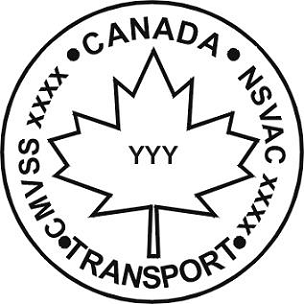
Visits this site for more information about car sear in New-Brunswick
http://www2.gnb.ca/content/gnb/en/departments/public_safety/drivers_vehi...
b. Car Seats
Although you can purchase hundreds of items for your baby, it is important to know that only a few are mandatory. The car seat is one of these items.
The law requires that babies always ride in a car seat even on the first trip home from the hospital. As your child grows, he or she will need a new seat, followed by a booster seat. Booster seats are required by law, for children under the age of eight, weighing between 18kg and 36kg and are less than 145cm tall. Once a child exceeds any one of the above criteria they may be ready to use a seat belt alone. Check to make sure that when your child is sitting in the seat that the shoulder strap sits across the chest and shoulder bone and the lap belt sits across the hip bones and not across the stomach.
Even if you don't own a car, you will need a car seat for your baby when you take a taxi or travel with a friend. A car seat can also be used as a seat in the home.
